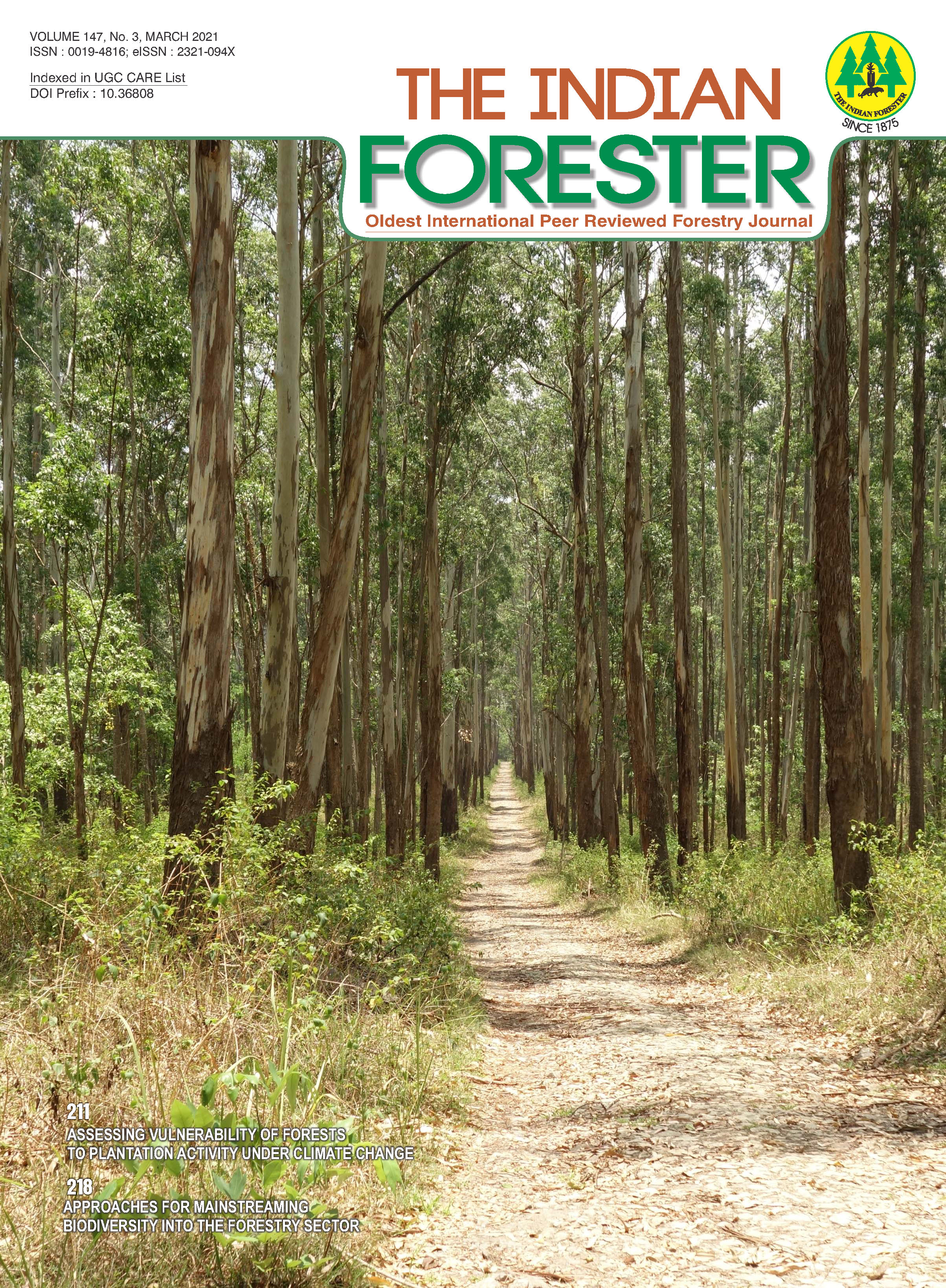Diversity Pattern of Climbing Plants in Relation to Aquatic Sources in Fragmented Wild Patches
DOI:
https://doi.org/10.36808/if/2021/v147i3/151197Keywords:
Climber, Lentic, Liana, Lotic, Sacred Groves.Abstract
Climbing plants play pivotal role in maintaining the structure and function of tropical ecosystems including fragmented wild patches. Besides the phorophytes, water sources are very significant to the climbers for their diversity and abundance. Being opportunistic in nature, climbing plants have to quest for easy access to water sources. Fragmented wild patches foster to sustain the diversity and abundance of climbing plants. The major objective of the present study is to understand the influence of aquatic sources on the diversity patterns of climbing plants in fragmented wild patches. Thirty such wild patches in the western lateritic region of West Bengal, India were selected for the present study. These wild patches were divided into three categories (with 10 patches in each) based on types of available water sources (i.e. lentic/lotic) and its absence. Individual counts of every species of trees and climbing plants was done in each patch for performing dissimilarity analysis. Study reveals that water sources are one of the key factors for the diversity patterns irrespective of soil types. Result shows that maximum dissimilarity lies between the patches adjacent to lentic system and those are not close to any water source. Dissimilarity was highest between patches with lentic and patches with lotic system in case of climbers with secondary growth. These findings would be helpful in the management of degraded forest patches especially through intervention of maintaining essential diversity and coverage of climbing plants with necessary aquatic sources.References
Allen B.P., Pauley E.F. and Sharitz R.R. (1997). Hurricane impacts on liana populations in an old-growth southeastern bottomland forest. Journal of Torrey Botanical Society, 124: 34 42.
Carse L.E., Fredericksen T.S. and Licona J.C. (2000). Lianatree species association in Bollivian dry forest. Tropical Ecology, 41(1): 1-10.
Ewers F.W., Fischer J.B. and Fichtner K. (1991). Water flux and xylem structure in vines. In: Biology of vines (F.E. Putz and H.A. Mooney, Eds.), Cambridge University Press, Cambridge, UK, pp 127-160.
Gartner B.L., Bullock S.H., Mooney H.A., Brown V.B. and Whitbeck J.L. (1990). Water transport properties of vine and tree stems in a tropical deciduous forest. American Journal of Botany, 77: 42-749.
Gianoli E., Torresâ€DÃaz C., Ruiz E., Salgadoâ€Luarte C., Molinaâ€Montenegro M.A., Saldaña A. and RÃos R.S. (2016). Woody climbers show greater population genetic differentiation than trees: insights into the link between ecological traits and diversification. Evolution, 70: 2736-2745.
Gianoli E. (2015). The behavioural ecology of climbing plants. AoB Plants, 7: plv013.
Homeier J., Breckle S.W., Günter S., Rollenbeck R.T. and Leuschner C. (2010). Tree diversity, forest structure and productivity along altitudinal and topographical gradients in a species-rich Ecuadorian montane rain forest. Biotropica, 42: 140-148.
Hooker J.D. (1872-1897). Flora of British India. L. Reeve. London.
Kumar M., Bhatt V.P. and Rajwar G.S. (2006). Plant and soil diversities in a sub-tropical forest of the Garhwal Himalaya. Ghana Journal of Forestry, 19-20: 1-19.
Laurance W.F., Perez-Salicrup D., Delamonica P., Fearnside P.M., D'Angelo S., Jerozolinski A., Pohl L. and Lovejoy T.E. (2001). Rain forest fragmentation and the structure of Amazonian liana communities. Ecology, 82: 105-116.
Madeira B.G., EspÃrito-Santo M.M., Dangelo Neto S., Nunes Y.R.F., Sanchez-Azofeifa G.A., Fernandes G.W. and Quesada M. (2009). Changes in tree and liana communities along a successional gradient in a tropical dry forest in southeastern Brazil. Plant Ecology, 291: 291-304.
Malavat R. and Mani S. (2015). Water retention characteristics in red lateritic soils, red soils and black soils of Tamil Nadu in relation to soil texture. International Journal Agricultural Science, 11(2): 307-315.
Manna S., Manna S., Ghora T.K. and Roy A. (2017). Sacred grove as remnant forest: A vegetation analysis. Biodiversitas, 18: 899-908.
Paul G.S. and Yavitt J.B. (2011). Tropical Vine Growth and the Effects on Forest Succession: A Review of the Ecology and Management of Tropical Climbing Plants. Botanical Review, 77: 11-30.
Pérez-Salicrup D.R. and Barker M.G. (2000). Effect of liana cutting on water potential and growth of Sennamultijuga (Caesalpiniodeae) trees in a Bolivian tropical forest. Oecologia, 124: 369-475.
Prain D. (1903). Bengal Plants. Bishen Sing and Mahendra Pal Sing. Dehradun, India.
Putz F.E. and Windsor D.M. (1987). Liana phenology on Barro Colorado Island, Panama. Biotropica, 19: 334-341.
Schnitzer S.A., Dalling J.W. and Carson W.P. (2000). The impact of lianas on tree regeneration in tropical forest canopy gaps: evidence for an alternative pathway of gap-phase regeneration. Journal of Ecology, 88: 655-666.
Schnitzer S.A. and Bongers F. (2002). The ecology of lianas and their role in forests. Trends in Ecology and Evolution, 17: 223-230.
Schnitzer S.A. (2005). A mechanistic explanation for global patterns of liana abundance and distribution. American Naturalist, 166: 262-276.
Schnitzer S.A., Kuzee M.E. and Bongers F. (2005). Disentangling above- and below-ground competition between lianas and trees in a tropical forest. Journal of Ecology, 93: 1115-1125.
The International Plant Names Index. Available at: http://www.ipni.org/ipni/plantnamesearchpage.do
The Plant List. Available at: http://www.theplantlist.org
Tropicos. Available at: http://www.tropicos.org
Van Der Heijden G.M.F. and Phillips O.L. (2008). What controls liana success in Neotropical forests? Global Ecology and Biogeography, 17: 372-383.
Vivek P. and Parthasarathy N. (2017). Patterns of tree-liana interactions: distribution and host preference of lianas in a tropical dry evergreen forest in India. Tropical Ecology, 58(3): 591-603.
Downloads
Downloads
Published
How to Cite
Issue
Section
License
Unless otherwise stated, copyright or similar rights in all materials presented on the site, including graphical images, are owned by Indian Forester.





